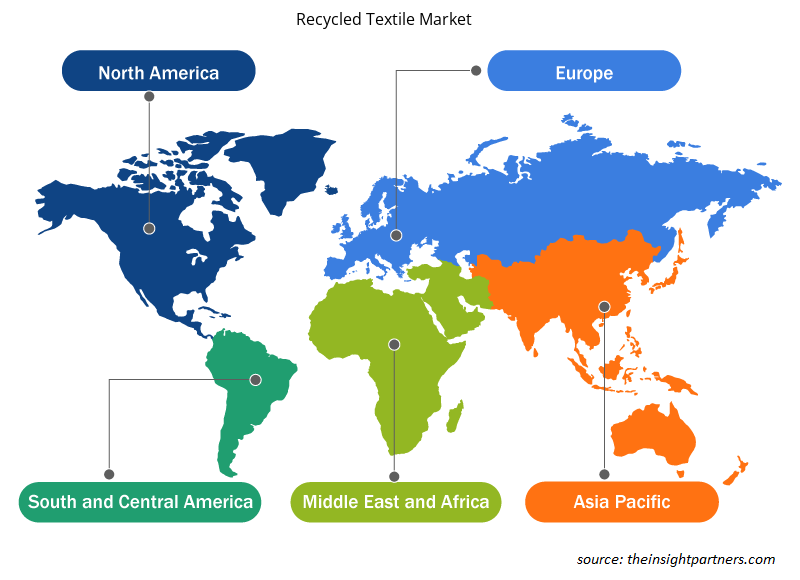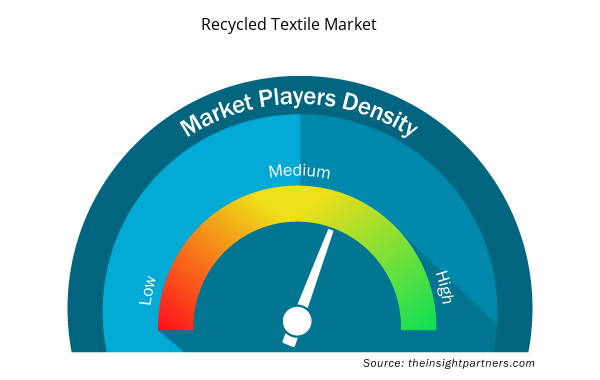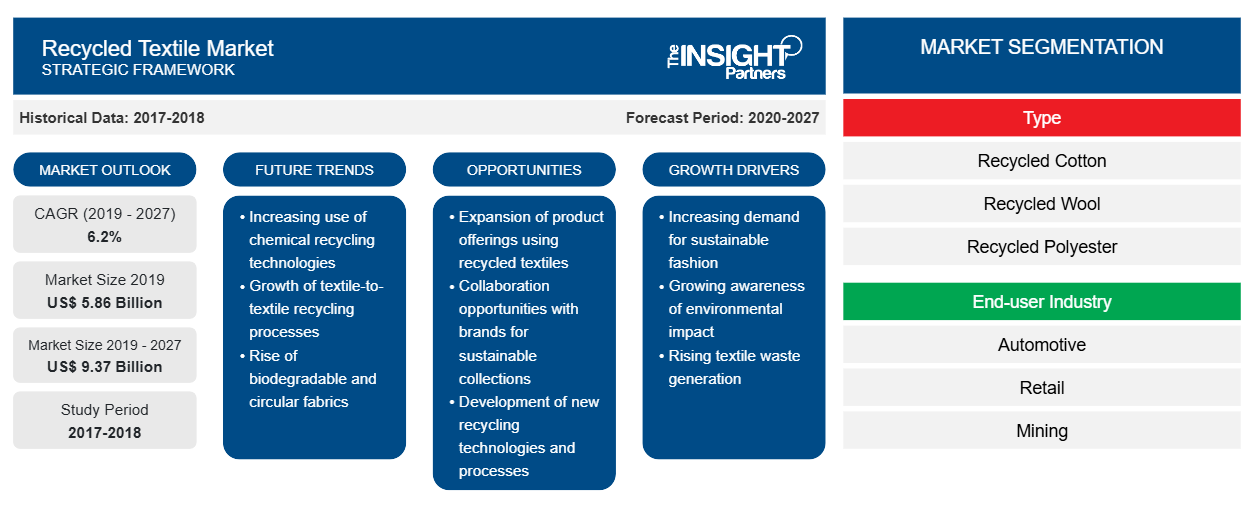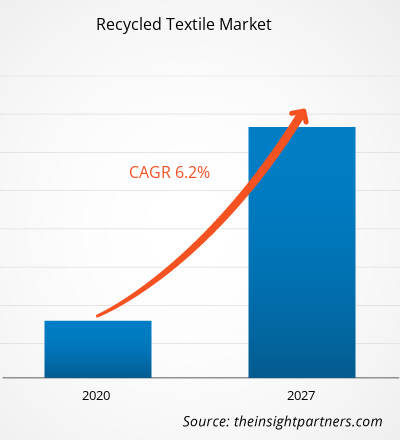リサイクル繊維市場は2019年に58億5,539万米ドルと評価され、2027年までに93億6,504万米ドルに達すると予測されており、2020年から2027年にかけて6.2%のCAGRで成長すると予想されています。
リサイクル繊維とは、再利用または材料回収のために回収できる古着やその他の未使用の繊維のことです。近年、環境に悪影響を与える可能性のある繊維廃棄物の処分に関する懸念が世界中で高まっています。リサイクル繊維の需要は、衣類、織物、自動車などを含むいくつかの最終用途産業からの需要の急増により、世界中で高まっています。メーカーは、使用済みの繊維を、さまざまな最終用途産業で使用できるより良い製品にリサイクルするために、いくつかの技術を採用しています。資源のリサイクルは、主に熱、機械、化学技術の助けを借りて行うことができます。
ヨーロッパは、同地域での政府の取り組みの高まりにより、リサイクル繊維の重要な市場となっています。さらに、自動車業界におけるリサイクル繊維製品の需要の高まりは、市場で活動するリサイクル繊維市場のプレーヤーにとって有利な機会を提供します。購買力の増加とライフスタイルの変化が相まって、ヨーロッパ地域の繊維市場の成長を促進する主な要因の1つです。ヨーロッパでは、消費者が使用した衣類の約15%がリサイクルされており、使用済み衣類の75%以上がメーカーによって工業用にリサイクルされています。ヨーロッパでのリサイクル繊維の需要は、過去数年間で最も高いペースで成長しています。リサイクル繊維の生産者は、ドイツ、イギリスなどの国に注力しており、これがヨーロッパ地域でのリサイクル繊維の大きな需要につながっています。循環型繊維経済に対する消費者の関心の高まりも、この地域の市場成長を大幅に押し上げると予想されています。
2020年8月現在、確認された症例と報告された死亡者数で最も影響を受けている国には、米国、ブラジル、インド、ロシア、南アフリカ、メキシコ、スペイン、英国などがあります。COVID-19は、ロックダウン、渡航禁止、事業停止により、さまざまな国の経済や産業に影響を及ぼしています。世界の化学および材料産業は、サプライチェーンの中断、COVID-19の発生による製造の混乱など、深刻な混乱に見舞われている主要産業の1つです。たとえば、中国は製造業の世界的な拠点であり、さまざまな産業の最大の原材料サプライヤーです。中国やアジア太平洋、ヨーロッパなどの主要地域のさまざまな工場のロックダウンは、世界のサプライチェーンに影響を及ぼし、さまざまな商品の製造、納期、販売に悪影響を及ぼしています。これらすべての要因が、世界のリサイクル繊維市場に大きな影響を与えています。
要件に合わせてレポートをカスタマイズする
このレポートの一部、国レベルの分析、Excelデータパックなど、あらゆるレポートを無料でカスタマイズできます。また、スタートアップや大学向けのお得なオファーや割引もご利用いただけます。
- このレポートの主要な市場動向を入手してください。この無料サンプルには、市場動向から見積もりや予測に至るまでのデータ分析が含まれます。
市場分析
繊維廃棄物の処分に関する懸念の高まり
繊維製造の仕組みは、その工程全体を通じて大量の繊維廃棄物を生み出す化学集約型プロセスの 1 つであると考えられています。繊維廃棄物は、消費者前繊維廃棄物と消費者後繊維の 2 つのグループに分けることができます。繊維廃棄物の増加は環境に負担をかけ、既存の埋め立て地での効果的な処分または焼却の問題を引き起こします。推定によると、未使用の繊維製品の約 10~20% が廃棄されていると考えられています。たとえば、米国 EPA によると、2015 年には合計 1,575 万トンの繊維が都市固形廃棄物として生成され、そのうち 19% が焼却され、65% が埋め立てられました。さらに、米国環境保護庁のレポートでは、繊維の生産と廃棄によって温室効果ガスが排出されることが示唆されています。さらに、焼却のプロセスでは、重金属、ダイオキシン、酸性ガス、粉塵粒子などの有機物質が排出され、これらは人間と環境の両方に有害であると考えられています。また、残留灰にも高濃度の有毒物質が含まれているため、その処分も深刻な問題となっています。したがって、環境の持続可能性を促進するために、再利用またはリサイクル方法を通じて繊維廃棄物を効果的に管理することが極めて重要です。このような状況では、繊維廃棄物のリサイクルは実行可能な代替手段であると考えられており、天然資源への負担を軽減し、埋め立て地の必要性を最小限に抑え、エネルギーを節約するのに役立ちます。さらに、繊維廃棄物の効果的な管理を規制する厳格な政府法は、廃棄物に関連する差し迫った問題に対処するための持続可能な代替手段として繊維リサイクルの使用を促進することを目的としている可能性があります。
タイプインサイト
タイプに基づいて、リサイクル繊維市場は、リサイクル綿、リサイクルウール、リサイクルポリエステル、リサイクルナイロン、その他に分類されます。リサイクルナイロンセグメントは、2019年から2027年の予測期間中に最も高い成長率で成長すると予想されています。リサイクルナイロンは、工業用プラスチック、廃棄繊維、織物工場からの廃棄物、および使用済みの漁網から作られています。それらは、バージンナイロンと同じ品質の新しいナイロンに再生されます。ナイロンバッグ、ナイロン生地、ナイロンカーペットも、リサイクルナイロンに変換され、さらに使用されます。リサイクルナイロンの大部分は漁網から来ています。これは、海洋ゴミを転用するための優れたソリューションとして機能します。ナイロンのリサイクルは、ナイロンに比べて高価なプロセスですが、多くの環境上の利点があります。ナイロンをリサイクルすることで、廃棄物をなくし、製造からの温室効果ガス排出量を削減できます。原材料源としての石油への依存を軽減します。リサイクルナイロンを使用すると、使用されなくなったナイロン製品の新しいリサイクルストリームを促進するのにも役立ちます。機械的にリサイクルされる材料のほとんどは高温で溶解され、最終的に汚染物質を破壊して材料を再利用可能な形に変えます。ナイロンはリサイクル中に低温で溶解し、汚染物質を残します。そのため、ナイロンはリサイクル前に慎重に洗浄する必要があります。
エンドユーザー業界の洞察
エンドユーザー産業に基づいて、リサイクル市場は自動車、小売、鉱業、その他に分類されます。自動車セグメントは、2019〜2027年の予測期間中に最も高い成長率で成長すると予想されています。自動車業界で使用されているリサイクル繊維は、自動車部品の生産に大きく貢献しています。自動車用途でのリサイクル繊維の使用には、床材、室内装飾品、安全ベルトなどの目に見える部品と、チューブやテープ、タイヤコード、エアバッグ部品、繊維などの目に見えないリサイクル繊維が含まれます。リサイクル繊維は、引張強度、摩耗、通気性、圧縮抵抗、弾力性、洗浄のしやすさ、難燃性、動的気候条件への耐性のために自動車業界で使用されています。リサイクル綿は、シートの詰め物や自動車の断熱材に使用されます。
Anandi Enterprises、Chindi、Khaloom Textile India Pvt. Ltd.、Kishco Group などは、世界のリサイクル繊維市場における主要プレーヤーです。これらの企業は、顧客基盤を拡大し、世界中で大きな市場シェアを獲得するために、新製品開発や合併買収戦略を実施しており、その結果、プレーヤーは世界的にブランド名を維持できるようになりました。
リサイクル繊維市場の地域別分析
予測期間を通じてリサイクル繊維市場に影響を与える地域的な傾向と要因は、Insight Partners のアナリストによって徹底的に説明されています。このセクションでは、北米、ヨーロッパ、アジア太平洋、中東、アフリカ、南米、中米にわたるリサイクル繊維市場のセグメントと地理についても説明します。

- リサイクル繊維市場の地域別データを入手
リサイクル繊維市場レポートの範囲
| レポート属性 | 詳細 |
|---|---|
| 2019年の市場規模 | 58.6億米ドル |
| 2027年までの市場規模 | 93億7千万米ドル |
| 世界のCAGR(2019年 - 2027年) | 6.2% |
| 履歴データ | 2017-2018 |
| 予測期間 | 2020-2027 |
| 対象セグメント | タイプ別
|
| 対象地域と国 | 北米
|
| 市場リーダーと主要企業プロフィール |
|
市場プレーヤーの密度:ビジネスダイナミクスへの影響を理解する
リサイクル繊維市場は、消費者の嗜好の変化、技術の進歩、製品の利点に対する認識の高まりなどの要因により、エンドユーザーの需要が高まり、急速に成長しています。需要が高まるにつれて、企業は提供品を拡大し、消費者のニーズを満たすために革新し、新たなトレンドを活用し、市場の成長をさらに促進しています。
市場プレーヤー密度とは、特定の市場または業界内で活動している企業または会社の分布を指します。これは、特定の市場スペースに、その市場規模または総市場価値に対してどれだけの競合相手 (市場プレーヤー) が存在するかを示します。
リサイクル繊維市場で事業を展開している主要企業は次のとおりです。
- チンディ
- カルームテキスタイルインディア株式会社
- キシュコグループ
- ウシャヤーンズリミテッド
- アナディエンタープライズ
免責事項:上記の企業は、特定の順序でランク付けされていません。

- リサイクル繊維市場のトップキープレーヤーの概要を入手
レポートの注目点
- 世界のリサイクル繊維市場における進歩的な業界動向は、プレーヤーが効果的な長期戦略を策定するのに役立ちます。
- 先進国市場と発展途上国市場で採用されているビジネス成長戦略
- 2017年から2027年までの世界のリサイクル繊維市場の定量分析
- さまざまな業界における世界のリサイクル繊維需要の推定
- 市場の成長を予測するために業界で活動するバイヤーとサプライヤーの有効性を示すPEST分析
- 競争的な市場シナリオと世界のリサイクル繊維需要を理解するための最近の動向
- 世界のリサイクル繊維市場の成長を牽引・抑制する要因と相まって、市場の動向と見通しが明らかになった。
- 世界のリサイクル繊維市場の成長に関する商業的利益を支える戦略を理解することによる意思決定プロセス
- 市場のさまざまなノードにおける世界のリサイクル繊維市場の規模。
- 世界のリサイクル繊維市場の詳細な概要とセグメンテーション、および業界におけるその動向
- 有望な成長機会があるさまざまな地域の世界のリサイクル繊維市場規模
世界のリサイクル繊維市場(タイプ別)
- リサイクルコットン
- リサイクルウール
- リサイクルポリエステル
- リサイクルナイロン
- その他
世界のリサイクル繊維市場(エンドユーザー産業別)
- 自動車
- 小売り
- 鉱業
- その他
企業プロフィール
- アナディエンタープライズ
- チンディ
- カルームテキスタイルインディア株式会社
- キシュコグループ
- ウシャヤーンズリミテッド
- 暁星株式会社
- リーファイバーズ株式会社
- マーテックスファイバーサザンコーポレーション
- リニューセルAB
- ボーアグループ
- 過去2年間の分析、基準年、CAGRによる予測(7年間)
- PEST分析とSWOT分析
- 市場規模価値/数量 - 世界、地域、国
- 業界と競争環境
- Excel データセット



Report Coverage
Revenue forecast, Company Analysis, Industry landscape, Growth factors, and Trends

Segment Covered
This text is related
to segments covered.

Regional Scope
North America, Europe, Asia Pacific, Middle East & Africa, South & Central America

Country Scope
This text is related
to country scope.
よくある質問
Rising concerns related to the disposal of textile waste across the globe which may negatively impact the environment. The textile manufacturing mechanism is considered to be one of the chemical-intensive processes which generate a high volume of textile waste throughout its operations. The textile waste may be segregated into two groups, pre-consumer textile waste and post-consumer textile. The rise in amount of textile waste creates a burden on environment and generates the problem of effective disposal or incineration on existing landfills. According to an estimate, approximately 10–20% of all unused textile products are considered to be wasted. For instance, according to US EPA, in 2015, a total of 15.75 million tons of textiles were generated as municipal solid waste, of which 19% were incinerated, while 65 percent, ended in landfills.
Based on end user industry, the global recycled textiles market is segmented into automotive, retail, mining and others. The worldwide production of apparel and textile fibers has increased, owing to the tremendous rise in the global population. This has resulted in the generation of a high amount of textile wastes. In order to ensure sustainability and reduce the environmental impact, the textile and retail sectors have resorted to the recycling of textiles, which is a method of reusing and reprocessing used clothing, fibrous material, and clothing scraps from the manufacturing processes. Unwearable textiles are treated as damaged textiles and are processed in the factories as rags. The rags are collected and sent to the flocking and wiping industries.
The recycled nylon emerged as the fastest growing segment in the global market. Recycled nylon is made from industrial plastics, waste fibers, discards from weaving mills, and post-consumer fishing nets. They are regenerated into new nylon, which has the same quality as that of virgin nylon. Nylon bags, nylon fabrics, and nylon carpets are also converted into recycled nylon for further use. A large proportion of the recycled nylon comes from the fishing nets. It acts as a great solution to divert ocean garbage.
On the basis of type, the recycled textiles market is categorized into recycled cotton, recycled wool, recycled polyester, recycled nylon and others. In 2019, the recycled polyester segment dominated the market by accounting for 33.0% of the total market share. Over the period of the time, it has been observed that the consumption of polyester has been increased, which has perpetually increased the amount of waste. This propels the need to recycle polyester which helps to save energy and promote environment sustainability. Further, the textile produced from recycled polyester has the potential of being recycled repeatedly without posing any effect on the quality of the material. Also, the use of recycled polyester eliminates the dependency on petroleum as a raw material for the manufacture of fabrics. The manufactures involved in the business of recycled textiles mainly use closed-loop processes to refine old polyester into raw materials used for the production of new garments and other items.
The major players operating in the global recycled textile market are companies such as Gebrueder Otto Gmbh and Co. kg, Leigh Fibers Inc., Martex Fiber Southern Corp, Re NewcellAB, and Khaloom Textiles India Pvt. Ltd.
During the forecast period, Asia Pacific is anticipated to account for the largest share in the global recycled textile market, followed by Europe. The largest market share of the Asia Pacific region is primarily attributable to the growth of recycled textile market in China and the country currently holds 28.0% market share in Asia Pacific region. Fashion is the second most polluting industry in operation internationally, and the increasing pollution concerns in China has also influenced the recycled textile industry in the country. Rapid urbanization coupled with shift in lifestyle and rise in disposable income amongst consumer have altogether driven the demand for textile, leading to rise in amount of textile waste in the region. Hence, recycling of textile waste has been adopted as a suitable alternative amongst developed and developing economies of the region to keep in line with objective of environment sustainability.
Trends and growth analysis reports related to Chemicals and Materials : READ MORE..
The List of Companies - Recycled Textile Market
- Chindi
- Khaloom Textile India Pvt. Ltd
- Kishco Group
- Usha Yarns Limited
- Anandi Enterprise
- Boer Group
- Hyosong Corporation
- Leigh Fibers Inc.
- Martex Fiber Southern Corporation
- Renewcell AB
The Insight Partners performs research in 4 major stages: Data Collection & Secondary Research, Primary Research, Data Analysis and Data Triangulation & Final Review.
- Data Collection and Secondary Research:
As a market research and consulting firm operating from a decade, we have published and advised several client across the globe. First step for any study will start with an assessment of currently available data and insights from existing reports. Further, historical and current market information is collected from Investor Presentations, Annual Reports, SEC Filings, etc., and other information related to company’s performance and market positioning are gathered from Paid Databases (Factiva, Hoovers, and Reuters) and various other publications available in public domain.
Several associations trade associates, technical forums, institutes, societies and organization are accessed to gain technical as well as market related insights through their publications such as research papers, blogs and press releases related to the studies are referred to get cues about the market. Further, white papers, journals, magazines, and other news articles published in last 3 years are scrutinized and analyzed to understand the current market trends.
- Primary Research:
The primarily interview analysis comprise of data obtained from industry participants interview and answers to survey questions gathered by in-house primary team.
For primary research, interviews are conducted with industry experts/CEOs/Marketing Managers/VPs/Subject Matter Experts from both demand and supply side to get a 360-degree view of the market. The primary team conducts several interviews based on the complexity of the markets to understand the various market trends and dynamics which makes research more credible and precise.
A typical research interview fulfils the following functions:
- Provides first-hand information on the market size, market trends, growth trends, competitive landscape, and outlook
- Validates and strengthens in-house secondary research findings
- Develops the analysis team’s expertise and market understanding
Primary research involves email interactions and telephone interviews for each market, category, segment, and sub-segment across geographies. The participants who typically take part in such a process include, but are not limited to:
- Industry participants: VPs, business development managers, market intelligence managers and national sales managers
- Outside experts: Valuation experts, research analysts and key opinion leaders specializing in the electronics and semiconductor industry.
Below is the breakup of our primary respondents by company, designation, and region:

Once we receive the confirmation from primary research sources or primary respondents, we finalize the base year market estimation and forecast the data as per the macroeconomic and microeconomic factors assessed during data collection.
- Data Analysis:
Once data is validated through both secondary as well as primary respondents, we finalize the market estimations by hypothesis formulation and factor analysis at regional and country level.
- Macro-Economic Factor Analysis:
We analyse macroeconomic indicators such the gross domestic product (GDP), increase in the demand for goods and services across industries, technological advancement, regional economic growth, governmental policies, the influence of COVID-19, PEST analysis, and other aspects. This analysis aids in setting benchmarks for various nations/regions and approximating market splits. Additionally, the general trend of the aforementioned components aid in determining the market's development possibilities.
- Country Level Data:
Various factors that are especially aligned to the country are taken into account to determine the market size for a certain area and country, including the presence of vendors, such as headquarters and offices, the country's GDP, demand patterns, and industry growth. To comprehend the market dynamics for the nation, a number of growth variables, inhibitors, application areas, and current market trends are researched. The aforementioned elements aid in determining the country's overall market's growth potential.
- Company Profile:
The “Table of Contents” is formulated by listing and analyzing more than 25 - 30 companies operating in the market ecosystem across geographies. However, we profile only 10 companies as a standard practice in our syndicate reports. These 10 companies comprise leading, emerging, and regional players. Nonetheless, our analysis is not restricted to the 10 listed companies, we also analyze other companies present in the market to develop a holistic view and understand the prevailing trends. The “Company Profiles” section in the report covers key facts, business description, products & services, financial information, SWOT analysis, and key developments. The financial information presented is extracted from the annual reports and official documents of the publicly listed companies. Upon collecting the information for the sections of respective companies, we verify them via various primary sources and then compile the data in respective company profiles. The company level information helps us in deriving the base number as well as in forecasting the market size.
- Developing Base Number:
Aggregation of sales statistics (2020-2022) and macro-economic factor, and other secondary and primary research insights are utilized to arrive at base number and related market shares for 2022. The data gaps are identified in this step and relevant market data is analyzed, collected from paid primary interviews or databases. On finalizing the base year market size, forecasts are developed on the basis of macro-economic, industry and market growth factors and company level analysis.
- Data Triangulation and Final Review:
The market findings and base year market size calculations are validated from supply as well as demand side. Demand side validations are based on macro-economic factor analysis and benchmarks for respective regions and countries. In case of supply side validations, revenues of major companies are estimated (in case not available) based on industry benchmark, approximate number of employees, product portfolio, and primary interviews revenues are gathered. Further revenue from target product/service segment is assessed to avoid overshooting of market statistics. In case of heavy deviations between supply and demand side values, all thes steps are repeated to achieve synchronization.
We follow an iterative model, wherein we share our research findings with Subject Matter Experts (SME’s) and Key Opinion Leaders (KOLs) until consensus view of the market is not formulated – this model negates any drastic deviation in the opinions of experts. Only validated and universally acceptable research findings are quoted in our reports.
We have important check points that we use to validate our research findings – which we call – data triangulation, where we validate the information, we generate from secondary sources with primary interviews and then we re-validate with our internal data bases and Subject matter experts. This comprehensive model enables us to deliver high quality, reliable data in shortest possible time.


 このレポートの無料サンプルを入手する
このレポートの無料サンプルを入手する